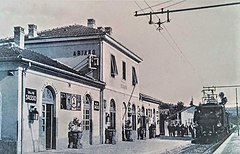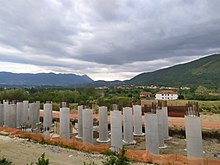|
Naples–Foggia railway
The Naples–Foggia railway is an Italian railway line connecting Naples, in Campania, with Foggia, in Apulia, crossing the Apennines at the saddle of Ariano through a series of tunnels. The railway infrastructure is managed by the Rete Ferroviaria Italiana, which classifies it as one of its primary lines.[4] It is part of a westward extension of Pan-European Corridor VIII. It is being developed as a line with features of high-speed rail with the doubling of single-track sections and the raising of line speeds to between 180 km/h and 200 km/h. These improvements are intended to allow connections between Naples and Bari in two hours and between Rome and Bari in three hours in 2026.[5] HistoryConstruction
The Società per le Strade Ferrate Meridionali ("Company for the Southern Railways") obtained a concession for the construction and operation of a railway that linked the Adriatic to the Tyrrhenian Sea, connecting Foggia to Naples, under the "Bastogi" law of 1862 that enabled the foundation of the company (law no. 763). In the previous decade, a railway project to connect Caserta with Foggia, taking advantage of the just completed Rome–Cassino–Naples railway, had been proposed to the government of the Kingdom of the Two Sicilies. The project subsequently collapsed due to political and financial problems. However the Società Meridionali preferred to resume that project rather than build a new line that started from Naples and crossed the Valle Caudina. Work began at both ends of the line.[7] The first section to be opened for operation was between Bovino and Foggia, on 27 January 1867, followed by several sections in the following year: Caserta–Casalduni (15 March), Casalduni–Benevento (18 April), Savignano–Bovino and Benevento–Santo Spirito (1 August). In 1869, these were followed by the sections between Starza and Pianerottolo (25 January) and between Pianerottolo and Savignano (12 June). The line was completed on 26 May 1870 with the opening of the section between Santo Spirito and Starza.[6] On the night of 29–30 September 1889 the line was the site of the Pianerottolo d'Ariano accident which caused two deaths and seven serious injuries due to a head-on collision between two trains inside the Ariano tunnel. The Ferrovie dello Stato took over the operation of the line following the nationalisation of the railways, including the lines built by the Società Meridionale, in 1906.[8] Electrification The Benevento–Foggia section was the first line to be electrified at 3000 volts DC.[9] The piling and the catenary were installed between 1926 and 1928. Test runs began in September 1927, with trains pulled by FS Class E.626 electric locomotives. Regular electric operations began on 1 March 1928.[10][note 1] Electrification was extended to Caserta and Naples in 1931.[10] Track duplicationDuplication of the line began in the 1990s. The new section between Vitulano and Apice was opened on 3 December 1997, replacing a more tortuous route. On the same day, the old Vitulano station, which was on the old route, was closed and replaced by the new Vitulano station, which has also since closed.[7] Adaptation of the whole line to "high capacity" (Alta Capacità) standards by 2026 is under way on several sections.[11] In July 2015, a link was activated that allows a direct connect to the Adriatic railway without reversal in Foggia.[12] In addition, a deviation was opened that connects Bovino with Foggia without passing through Cervaro station, which is now only used as a crossing loop. Work on the first segment (18.5 km) was completed in December 2012, while the entire section (23 km) was completed in 2016 and opened on 28 June 2017.[13]  Further work is planned as follows:
StandardsThe railway is single track with the exception of the Naples–Caserta, Vitulano–Benevento–Apice and Bovino–Foggia sections. The line is electrified at 3000 volts DC. Traffic controlRailway traffic on the section between Caserta and Cervaro is regulated by an operations centre manager (Dirigente Centrale Operativo) based in Napoli Centrale, while between Cervaro and Foggia, operations are entrusted to local station masters. Rail trafficMost passenger traffic is carried by medium to long distance trains, with 10 ETR 485 Frecciargento services serving Caserta, Benevento and Foggia, and four InterCity services that also stop in Telese-Cerreto and Ariano Irpino. Regional traffic between Caserta and Benevento is modest and was initially operated by Aln 663 and 668 railcars, and by low-floor carriages hauled by E.464 locomotives, with the addition of the Minuetto diesel multiple units in 2004. In 2015 a pair of Jazz electric multiple units entered service on the Naples–Benevento section, together with a pair of Swing diesel multiple units on the Benevento–Caserta–Campobasso route. The Benevento–Foggia section has had no local services since 2010, therefore all the stations on the section (with the exception of Ariano Irpino, which are served by four InterCity services) still exist but are unused. ReferencesNotes
Footnotes
Sources
|
|||||||||||||||||||||||||||||||||||||||||||||||||||||||||||||||||||||||||||||||||||||||||||||||||||||||||||||||||||||||||||||||||||||||||||||||||||||||||||||||||||||||||||||||||||||||||||||||||||||||||||||||||||||||||||||||||||||||||||||||||||||||||||||||||||||||||||||||||||||||||||||||||||||||||||||||||||||||||||||||||||||||||||||||||||||||||||||||||||||||||||||||||||||||||||||||||||||||||||||||||||||||||||||||||||||||||||||||||||||||||||||||||||||||||||||||||||||||||||||||||||||||||||||||||||||||||||||||||||||||||||||||||||||||||||||||||||||||||||||||||||||||||||||||||||||||||||||||||||||||||||||||||||||||||||||||||||||||||||||||||||||||||||||||||||||||||||||||||||||||||||||||||||||||||||